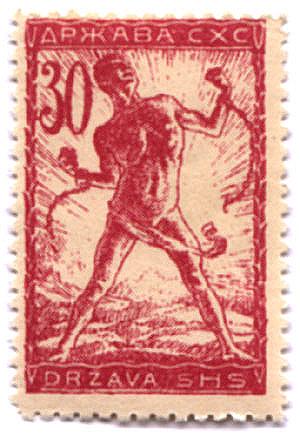
It’s one of the most iconic images in Slovenian history: a slave breaking off his chains. The legendary “Chainbreaker” postage stamps with this image were created to mark the Slovenian people’s quest for freedom at a time of great political change.
After World War I, Slovenia finally saw the collapse of the hated Hapsburg Empire and joined the newly created State of Slovenes, Croats, and Serbs. For ordinary people and intellectuals alike, this moment represented the final step in Slovenia’s national liberation.
Painter Ivan Vavpotič was asked to design a stamp – the new country’s first – to mark the occasion. He decided to use a highly allegorical image: a slave breaking off his chains while illuminated by light representing freedom. Stane Derganc, a well-known gymnast, served as Vavpotič’s model. Meanwhile, bilingual text – in the Latin and Cyrillic script – proclaimed the official name of the new country.
Thousands of stamps with the new motif were printed, even though the print run was smaller than initially intended because of a paper scarcity at the time. The stamps were intended to celebrate a new age of freedom, but the Slovenian people soon grew dissatisfied with the new state. It eventually became apparent that the multiethnic country did not represent a true liberation for the Slovenian people, who increasingly resented being ruled by Belgrade. Even Vavpotič became disillusioned with his design, which he did not consider one of his best works.
True political liberation would have to wait until Slovenia’s independence in 1991. The new country also began to issue its own stamps, and among them was a reprint of Vavpotič’s legendary design. Meanwhile, his image – prized by philatelists -- remains a classic symbol of the Slovenian people’s struggle for a better, and freer, tomorrow.

































































